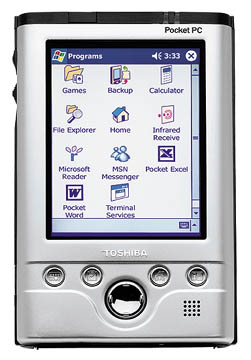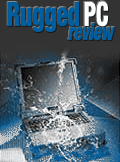Toshiba e740
First Pocket PC with Intel's 400MHz XScale chip. ATI graphics, and integrated wireless
 Pen Computing, October 2002 -- In terms of technology, little has happened in the Pocket PC arena lately. Comparing the current crop of products has gotten decreasingly interesting as the machines become more alike. Compaq continues to lead the pack while those remaining to compete are matching the iPAQ in every way they can. HP has dropped out of the fray with their recent subsuming of Compaq, which is a shame since my daily-driver Jornada 567 is the most reliable Pocket PC I've used to date. Casio is out of the picture -- for now, anyway, and NEC's MobilePro is flying low.
Pen Computing, October 2002 -- In terms of technology, little has happened in the Pocket PC arena lately. Comparing the current crop of products has gotten decreasingly interesting as the machines become more alike. Compaq continues to lead the pack while those remaining to compete are matching the iPAQ in every way they can. HP has dropped out of the fray with their recent subsuming of Compaq, which is a shame since my daily-driver Jornada 567 is the most reliable Pocket PC I've used to date. Casio is out of the picture -- for now, anyway, and NEC's MobilePro is flying low.
Then there is Toshiba, the new kid on the block. With commanding resources including billion-dollar R&D investments and world-class manufacturing capability, Toshiba wants to play -- and they are not content to take a following role in the technology department. The new e740 offers three firsts in the Pocket PC space:
- Intel's 400MHz XScale PXA250 chip, the latest iteration of the StrongARM technology that's been the muscle in the world's most powerful PDAs since Apple's Newton ruled the earth.
- Built-in 11 Mbps WiFi (802.11b) wireless Ethernet networking for broadband Internet access from any private or public "hot spot."
- ATI Imageon 100 2D video processor for faster, smoother graphic performance when using applications designed to take advantage of the chip.
You'd expect the performance of the new XScale chip to be the big news here, but it turns out that the performance improvement is marginal. Applications must be written to take advantage of the unique properties of the new microprocessor, including its ability to downshift to slower, less battery-intensive speed levels when the task at hand does not require all 400MHz chewing up your milliamp-hours.
The big news
No, the big news is built-in WiFi. Reliable WiFi CompactFlash cards from Socket and Symbol have been around for some time, but the advantage of integration makes a real difference. On the e740, the drivers and control panels are in the device's ROM, so you'll never lose your ability to connect if your unit gets its memory erased -- an unpleasant event that is all too common an occurrence for Pocket PC users. (Though I may be harder on my machines than most end users, my Pocket PCs experience total amnesia around once a month, usually when I'm traveling. Fastidious adherence to a backup regimen is the only thing that saves me from these machines. With a full backup on an SD or CF card, what would have been a serious disaster becomes a mere annoyance. With Pocket PCs, it's not a matter of if your data will spontaneously vaporize, but when it will.)
I compared the wireless signal range on the e740, with its integrated antenna, to my Jornada 567 with its Socket Low Power WLAN WiFi card. They were within a few feet of extinguishing simultaneously, and at a distance comparable to my main squeeze, an Apple PowerBook G4, and my Windows machine, a Fujitsu Lifebook P1035 -- both with integrated WiFi.
While the performance was world-class, the battery life plunged to around two hours when the WiFi radio was enabled. Toshiba included a handy on/off switch for the radio on the bottom of the e740, a switch you'll want to use whenever you are out of range to save your power pack from premature exhaustion. Happily, Toshiba offers an optional high-capacity battery pack for heavy wireless users on the go.
Powerlessness
Speaking of power loss, the Toshiba e740 has a major design flaw that can cost you all your work. The removable 1000mAh lithium-ion battery pack is released by a vertical slider on the side of the device that can easily be disengaged by sliding out of a tight pocket. When the battery pops out, even a little, all your data is instantly gone. You could cover the switch with silver tape, but it's a shame to have to do such a kludgy thing on a US$600 handheld computer.
While we're hanging out in the complaint department, let me also mention that I found the position of the voice recording button to be exasperating. Every time I took the unit out of its slipcase, I pushed the button accidentally. I finally solved the issue by assigning a more useful action for this switch: it takes me to the Today screen, something I'm far more likely to want to see when I first pull the machine out.
Self storage
With the mere addition of a few millimeters of thickness and about an ounce in weight compared to the entry level e310, Toshiba has managed to cram just about every feature you could want in a pocket computer into the e740. You get both a CompactFlash slot and the increasingly desirable SecureDigital slot. With both these storage options available you have no excuse not to backup regularly to your preferred media. Since the e740 has 64MB of internal storage, I'd suggest investing in a 128MB SD card so you can back up your entire machine and still have room left over for 64MB of photos, ebooks, and music files. Save the CF slot for a Bluetooth card, a GPS receiver, or a GPRS modem. Thus equipped, there is little you cannot do with this rig.
For business users, Toshiba offers an optional US$100 expansion pack for displaying presentations on standard projectors. It clips to the bottom of the unit for easy handling while you stand and deliver using the device as your handheld teleprompter. The e740 includes IA Presenter, software for editing and displaying PowerPoint slides.
Even with its minor flaws, the Toshiba e740 is a real contender in the race for Pocket PC marketshare at the high end of the spectrum, a space dominated by Compaq's increasingly pricey iPAQs. It offers more value for your dollar than the iPAQ and is slightly smaller overall when you take into account the iPAQ's CF sled. If you favor a clean, utilitarian design aesthetic, are a regular user of WiFi networks, and don't mind having a centimeter of tape over the battery release, the e740 is worth a very serious look. -David MacNeill
|


 Pen Computing, October 2002 -- In terms of technology, little has happened in the Pocket PC arena lately. Comparing the current crop of products has gotten decreasingly interesting as the machines become more alike. Compaq continues to lead the pack while those remaining to compete are matching the iPAQ in every way they can. HP has dropped out of the fray with their recent subsuming of Compaq, which is a shame since my daily-driver Jornada 567 is the most reliable Pocket PC I've used to date. Casio is out of the picture -- for now, anyway, and NEC's MobilePro is flying low.
Pen Computing, October 2002 -- In terms of technology, little has happened in the Pocket PC arena lately. Comparing the current crop of products has gotten decreasingly interesting as the machines become more alike. Compaq continues to lead the pack while those remaining to compete are matching the iPAQ in every way they can. HP has dropped out of the fray with their recent subsuming of Compaq, which is a shame since my daily-driver Jornada 567 is the most reliable Pocket PC I've used to date. Casio is out of the picture -- for now, anyway, and NEC's MobilePro is flying low.